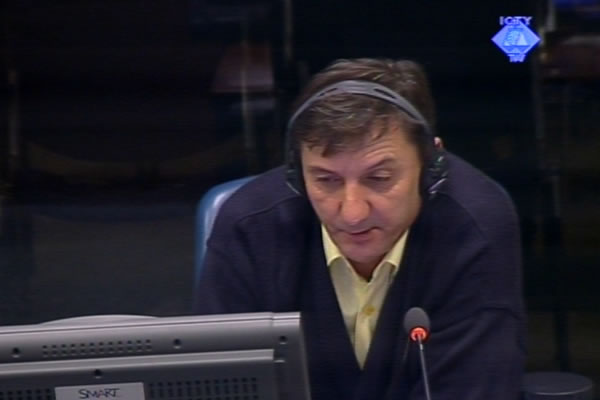Home
KARADZIC’S WITNESS: ‘WE WERE CAUTIOUS’
Slobodan Tusevljak, commander of the fourth platoon in the 1st Sarajevo Mechanized Brigade claimed, as did previous Radovan Karadzic’s witnesses, that the Serb army engaged only in defensive actions, that it was ‘cautious’ and didn’t fire on civilians in Sarajevo
 Slobodan Tusevljak, defence witness of Radovan Karadzic
Slobodan Tusevljak, defence witness of Radovan Karadzic Slobodan Tusevljak was the last of today’s defense witnesses of Radovan Karadzic. In the war Tusevljak was a platoon commander in the VRS 1st Sarajevo Mechanized Brigade. According to the summary of the written statement read out by Karadzic the witness’s unit launched only ‘defensive actions’. Muslim forces on the other hand ‘attacked’ and each day they shelled them with mortar fire. The witness’s platoon had only one mortar but not shells, the witness claimed.
According to the summary, Tusevljak’s unit was ‘cautious’ and didn’t fire on civilians in Sarajevo. The witness never allowed anyone to open fire on the city and civilian targets. Tusevljak and other members of his platoon, as well as Tusevljak’s superior command, ‘had no intention’ of causing civilian casualties or terrorizing civilians and they didn’t attack public transport vehicles. The witness never received an order to open fire on civilians. On the contrary, the order was to fire only on the enemy forces, in self-defense.
Through this witness, Karadzic tried to contest two sniper incidents listed in the indictment against him. The first incident happened on 3 September 1993 in Ivana Krndelja Street and the second was on 22 July 1994 in Miljenka Cvitkovica Street in the neighborhood of Cengic Vila. In both cases there ‘was no direct line of light from the positions held by my unit and the scene of incident’. The witness contends that his platoon didn’t have sniper rifles and the personnel who knew how to use them. It was only in late 1993 that a sniper was assigned to his unit but he was killed two days later.
As prosecutor Carolyn Edgerton noted in her cross-examination, VRS documents show that Serb forces were attacking the city in the area of responsibility of the witness’s unit. Ratko Mladic confirmed it in his diary when he noted on 27 June 1992 that an action by the Serb forces was ‘underway’ to take Hrasno and Asimovo Brdo. The witness argued that he was unaware of any attacks.
The witness was shown several photos made by the prosecution in Sarajevo. One photo showed there was line of sight from Ozrenska Street located on a hill controlled by the Serb forces to the scene of the incident in Ivana Krndelja Street. Two other photos were taken at the scene of the incident in Miljenka Cvitkovica Street; they also show the scene was visible from the VRS positions in Ozrenska Street. The witness contends that Ozrenska Street was not in the area of responsibility of his platoon because it was positioned ‘closer to Mojmilo’. Ozrenska Street was held by the first or second platoon; the witness claimed he couldn’t remember the names of their commanders.
Tusevljak claimed that his platoon didn’t have weapons that could hit targets at a range of about 1,200 meters. The claim prompted the prosecutor to show him documents indicating that the witness’s unit had long-range machine guns, called ‘death sowers’. The documents also show that in 1993, the 1st Romanija Brigade had 68 sniper rifles of various calibers and that a group of snipers that was part of a military police platoon operated in the Grbavica area. ‘I don’t know about Grbavica’, the witness said. According to the witness, the positions of his platoon were far from that part of Sarajevo, which was under the VRS control during the war.
Linked Reports
- Case : Karadzic
- 2012-11-06 ‘JOINT COMMISSION’: DID IT REALLY EXIST?
- 2012-11-05 MOMIR CLAIMS HE’S ‘MOCALO’ NOT ‘MOMO’
- 2012-11-01 RESPONSIBILITY FOR MARKALE MASSACRE CONTESTED AGAIN
- 2012-11-08 KARADZIC’S WITNESS: BOSNIAN GOVERNMENT KILLED PEOPLE IN SARAJEVO
- 2012-11-12 KARADZIC’S WITNESS DENIES ‘PUNISHMENT SHELLING’
- 2012-11-13 KARADZIC HOPES ORIC MIGHT HELP HIM
